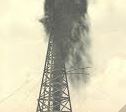
By Joyce L. Alig, President, Mercer County Historical Society
When I read the note on the back of this post card, I really doubted that they used “about 100 quarts of nitroglycerin,” in shooting a well. Could that be true? I could not find a photograph of the derricks of the oil wells on the Reservoir, following a storm in the 1890’s. I did find stories of storms on the lake.
The January 20, 1897 Mercer County Standard carried the article, “HIGH WINDS Demolish the Derricks and Do Further Damage in the Oil Fields.”
“Houser & Co. had a derrick blown down on the TouVelle lease. Derrick No. 3 on the Miller lease was left in a slanting position. The belt house and walking beam at Bryson No. 4 were blown down. The derrick at the Landfair well No. 1 went down before the wind, this making the second time this derrick has been laid low.
“Out on the Pond [Reservoir], Wade & Stafford’s pile driver was knocked out of place by the wind. The Lake Center Oil Company’s cook shanty left its foundation and found a place in the lake. Several derricks belonging to the Manhattan Oil Company are down. Out at Jewett’s Point, the high winds piled up the ice from the pond to a height of from eight to ten feet. Luckily, no accidents occurred to any of the men in the oil fields as it was a day of deadly danger from falling derricks and pieces of timber that were blown about at the sport of the wind.”

Shooting an oil well with about 100 quarts of glycerin, near West Bank of the Reservoir, Celina, Ohio; it went about 100 feet in the air. Fritz.
The February 1, 1899 Mercer County Standard reported, “HAVOC AMONG THE DERRICKS.”
“The high winds and the ice on Thursday last played havoc with the derricks in Lake Mercer. A number of them were thrown over and in consequence the pumpers at several of the wells have been out of a job since that time.
“Matt Alberry, who was out on the lake looking after the Mike Linn lease was prevented from getting home that night and his family members were greatly alarmed.
“A pumper on the Reservoir, seeing the approach of the storm and realizing his danger, made ready to start across the ice to the shore, a distance of about a hundred yards. Just as he was ready to leave the derrick he noticed a great cake of ice, a hundred feet or so square, break loose and begin to float from his location. Thinking it a safer plan to take his chances on the floating ice than on the frame structure, he gave a jump and landed safely upon the ice, which, instead of going his way, began moving from the direction of the shore and into deep water. The pumper jumped from the ice into the water and waded to the shore, and for a time the water was up to his shoulders. After reaching shore, he had a half mile to go before reaching a dwelling, for safety.”
All too often, when people talk about the history of oil wells on this lake, they see the images of oil wells on a calm lake in the summertime. They remember that this lake apparently was the first inland body of water, to have oil wells on the water, in the world. They are both great stories which need to be preserved for the history of Mercer County. These two stories of storms on the Reservoir are frightening stories, where Mercer Countians faced potential disasters of survival. These stories also need to be preserved.
I appreciate the stories which illustrate the history of Mercer Countians as they actually lived their daily lives. I am seeking true stories about individuals who worked on the oil derricks above the oil wells on the Reservoir, especially photographs of the Derricks on the Reservoir following a storm.
[The Mercer County Historical Society President Joyce Alig, may be contacted at 3054 Burk-St. Henry Road, Saint Henry, OH 45883, or histalig@bright.net or 419-678-2614.]
